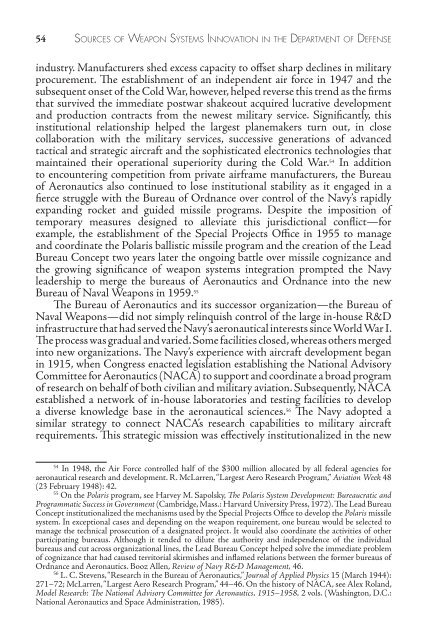To download as a PDF click here - US Army Center Of Military History
To download as a PDF click here - US Army Center Of Military History
To download as a PDF click here - US Army Center Of Military History
You also want an ePaper? Increase the reach of your titles
YUMPU automatically turns print PDFs into web optimized ePapers that Google loves.
54 so u R c e s o f we a p o n sy s T e m s In n o v a T Io n In T h e depaR TmenT o f defense<br />
industry. Manufacturers shed excess capacity to offset sharp declines in military<br />
procurement. The establishment of an independent air force in 1947 and the<br />
subsequent onset of the Cold War, however, helped reverse this trend <strong>as</strong> the firms<br />
that survived the immediate postwar shakeout acquired lucrative development<br />
and production contracts from the newest military service. Significantly, this<br />
institutional relationship helped the largest planemakers turn out, in close<br />
collaboration with the military services, successive generations of advanced<br />
tactical and strategic aircraft and the sophisticated electronics technologies that<br />
maintained their operational superiority during the Cold War. 54 In addition<br />
to encountering competition from private airframe manufacturers, the Bureau<br />
of Aeronautics also continued to lose institutional stability <strong>as</strong> it engaged in a<br />
fierce struggle with the Bureau of Ordnance over control of the Navy’s rapidly<br />
expanding rocket and guided missile programs. Despite the imposition of<br />
temporary me<strong>as</strong>ures designed to alleviate this jurisdictional conflict—for<br />
example, the establishment of the Special Projects <strong>Of</strong>fice in 1955 to manage<br />
and coordinate the Polaris ballistic missile program and the creation of the Lead<br />
Bureau Concept two years later the ongoing battle over missile cognizance and<br />
the growing significance of weapon systems integration prompted the Navy<br />
leadership to merge the bureaus of Aeronautics and Ordnance into the new<br />
Bureau of Naval Weapons in 1959. 55<br />
The Bureau of Aeronautics and its successor organization—the Bureau of<br />
Naval Weapons—did not simply relinquish control of the large in-house R&D<br />
infr<strong>as</strong>tructure that had served the Navy’s aeronautical interests since World War I.<br />
The process w<strong>as</strong> gradual and varied. Some facilities closed, w<strong>here</strong><strong>as</strong> others merged<br />
into new organizations. The Navy’s experience with aircraft development began<br />
in 1915, when Congress enacted legislation establishing the National Advisory<br />
Committee for Aeronautics (NACA) to support and coordinate a broad program<br />
of research on behalf of both civilian and military aviation. Subsequently, NACA<br />
established a network of in-house laboratories and testing facilities to develop<br />
a diverse knowledge b<strong>as</strong>e in the aeronautical sciences. 56 The Navy adopted a<br />
similar strategy to connect NACA’s research capabilities to military aircraft<br />
requirements. This strategic mission w<strong>as</strong> effectively institutionalized in the new<br />
54 In 1948, the Air Force controlled half of the $300 million allocated by all federal agencies for<br />
aeronautical research and development. R. McLarren, “Largest Aero Research Program,” Aviation Week 48<br />
(23 February 1948): 42.<br />
55 On the Polaris program, see Harvey M. Sapolsky, The Polaris System Development: Bureaucratic and<br />
Programmatic Success in Government (Cambridge, M<strong>as</strong>s.: Harvard University Press, 1972). The Lead Bureau<br />
Concept institutionalized the mechanisms used by the Special Projects <strong>Of</strong>fice to develop the Polaris missile<br />
system. In exceptional c<strong>as</strong>es and depending on the weapon requirement, one bureau would be selected to<br />
manage the technical prosecution of a designated project. It would also coordinate the activities of other<br />
participating bureaus. Although it tended to dilute the authority and independence of the individual<br />
bureaus and cut across organizational lines, the Lead Bureau Concept helped solve the immediate problem<br />
of cognizance that had caused territorial skirmishes and inflamed relations between the former bureaus of<br />
Ordnance and Aeronautics. Booz Allen, Review of Navy R&D Management, 46.<br />
56 L. C. Stevens, “Research in the Bureau of Aeronautics,” Journal of Applied Physics 15 (March 1944):<br />
271–72; McLarren, “Largest Aero Research Program,” 44–46. On the history of NACA, see Alex Roland,<br />
Model Research: The National Advisory Committee for Aeronautics, 1915–1958, 2 vols. (W<strong>as</strong>hington, D.C.:<br />
National Aeronautics and Space Administration, 1985).

















